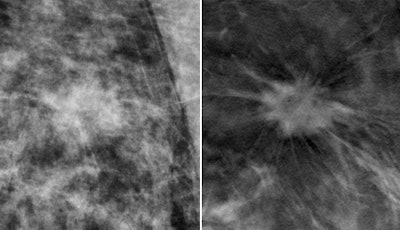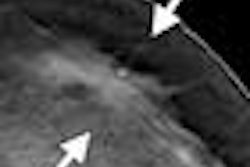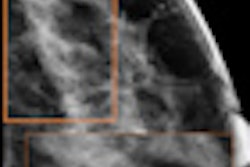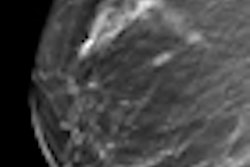
Adding digital breast tomosynthesis (DBT) to digital mammography not only boosts diagnostic accuracy, it also reduces the false-positive recall rate, according to a new study published online November 20 in Radiology.
"Tomosynthesis addresses two of digital mammography's flaws: missed cancers and false positives," lead author Dr. Elizabeth Rafferty, from Massachusetts General Hospital, told AuntMinnie.com.
Conventional digital mammography produces two x-ray images of each breast, while breast tomosynthesis acquires multiple low-dose images from different angles, which are then used to create a 3D reconstruction. Both digital mammography and breast tomosynthesis can be performed on the same mammography equipment in rapid succession, according to Rafferty's group.
The researchers compared radiologists' diagnostic accuracy and recall rates for breast tomosynthesis combined with digital mammography to that of digital mammography alone. Their study included 1,192 women recruited from five sites between July 2006 and May 2007; 997 had usable datasets (780 screening cases and 217 women who needed prebiopsy breast imaging). Each of the women had a standard digital mammogram followed by breast tomosynthesis (Radiology, November 20, 2012).
With this information, Rafferty's team conducted two reader studies that involved 312 and 310 cases, respectively: 12 radiologists participated in the first reader study and 15 in the second. A total of 48 cancers were included in the first reader study and 51 in the second.
"We anticipated that radiologists would have some trouble just jumping from the comfortable modality they've used for 30 years to tomosynthesis, so we combined tomosynthesis with digital mammography," Rafferty told AuntMinnie.com. "Our readers could easily look at prior mammograms and also have both the 2D data on any calcifications as well as the tomosynthesis data on noncalcifications."
The combination of tomosynthesis and digital mammography increased diagnostic accuracy for all 27 radiologists. The diagnostic accuracy of the combined exam increased by 10.7% for radiologists in the first study and by 16% for those in the second study. As for false-positive recall rates, the combination of tomosynthesis and digital mammography reduced recall rates by 38.6% in reader study 1 and 17.1% in study 2.
"[Our findings demonstrate that] the effects of the technique are reproducible," Rafferty told AuntMinnie.com. "It's notable that all of our participating radiologists had significantly reduced recall rates, regardless of their degree of experience or whether they were specialists or generalists."
 |
| Digital mammography (left) and tomosynthesis (right) images of an invasive ductal carcinoma. Images courtesy of RSNA. |
Tomosynthesis is the next big thing -- for both screening and diagnostic mammography, according to Rafferty.
"Tomosynthesis isn't just a new face on old technology, but a fundamentally different way of imaging the breast," Rafferty told AuntMinnie.com. "This technology is definitely a game changer."



















